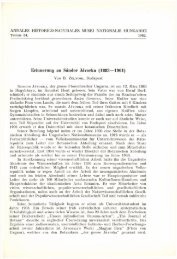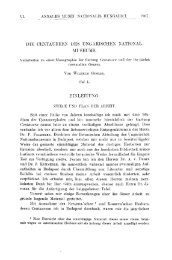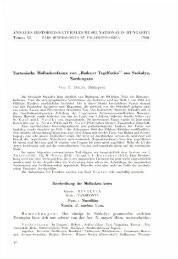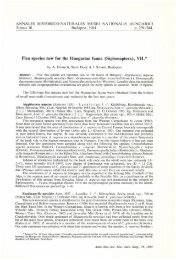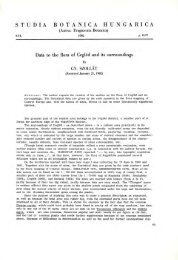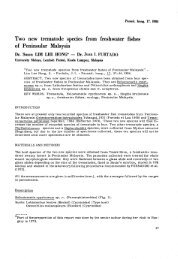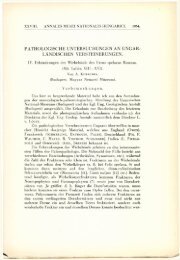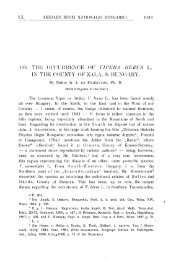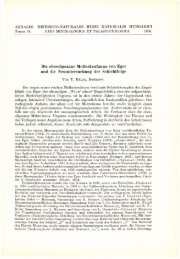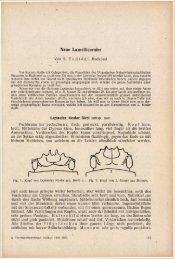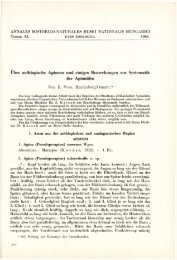New and little-known species of Carabidae from the Middle East and ...
New and little-known species of Carabidae from the Middle East and ...
New and little-known species of Carabidae from the Middle East and ...
Create successful ePaper yourself
Turn your PDF publications into a flip-book with our unique Google optimized e-Paper software.
30 E. Kirschenh<strong>of</strong>er<br />
(Fig. 21)<br />
sp. n.<br />
Type material – Holotype (female): “Malaysia-W, Perak, 30 km SE <strong>of</strong> IPOH, 900 m,<br />
Cameron Highl<strong>and</strong>, Ringlet, 26.–31.III.2000, leg. P. Èechovský” (CAD).<br />
Description – Habitus: Fig. 21. Length 8.3 mm, width 3.9 mm. Colour <strong>and</strong> lustre:<br />
head black; pronotum brownish black, sides broadly lighter brown; elytra black; marginal<br />
groove slightly lighter brown; each elytron with two large reddish yellow spots; anterior<br />
spot covering intervals 3 to 7 (but short on interval 3) <strong>and</strong> reaching posteriorly to just anteriorly<br />
<strong>of</strong> middle; <strong>the</strong> posterior spot covers intervals 2 to 8, short on interval 2, <strong>and</strong> posteriorly<br />
sinuate <strong>and</strong> anteriorly saw-too<strong>the</strong>d on interval 4; clypeus, labrum, m<strong>and</strong>ibles, palpi,<br />
antennae <strong>and</strong> legs reddish yellow; dorsum ra<strong>the</strong>r matt, with velvety sheen, glabrous. Venter<br />
shiny black, glabrous, elytral epipleura lighter brown. Pronotum: 2.04 times as wide as<br />
long, weakly convex; sides roundly narrowing anteriorly, widest before middle; posterior<br />
angles acute, weakly obtuse, sides weakly angled towards posterior angles; marginal<br />
groove broad, distinctly broadening towards base; anterior margin straight; posterior margin<br />
medially arcuate, basal impressions with widened pits; median line very finely incised,<br />
hardly reaching anterior margin or base. Elytra: broadly oval, feebly convex; basal margin<br />
complete, roundly meeting lateral margins; humeri well-developed, not declivous; marginal<br />
groove ra<strong>the</strong>r wide; outer angles <strong>of</strong> apical incision shortly rounded; apical end <strong>of</strong> elytral<br />
suture shortly rounded; striae deep, very finely punctate; intervals smooth, convex,<br />
third with three pore-punctures <strong>of</strong> which anterior adjacent to third stria, middle <strong>and</strong> posterior<br />
adjacent to second stria, middle just posterior to middle <strong>of</strong> elytron. Microsculpture:<br />
very fine throughout; roundly reticulate on head; finely transversely grooved on pronotum,<br />
densely chagreened between grooves; elytra with narrow transverse reticulation.<br />
Distribution – Malaysia: Perak.<br />
Etymology – This <strong>species</strong> is dedicated to <strong>the</strong> collector <strong>of</strong> this new <strong>species</strong>, Petr<br />
Èechovský (Prague).<br />
Comparisons – This <strong>species</strong> is similar to Coptodera farai JEDLIÈKA,<br />
1963 (type locality: “China, Yunnan, Solingho”) in <strong>the</strong> following features:<br />
anterolateral pronotal angles without bristles; elytra each with two large<br />
reddish yellow spots; distinct microsculpture dorsally; elytra clearly sinuate<br />
anteriorly <strong>of</strong> apex, with outer angles shortly rounded; apical end <strong>of</strong> elytral<br />
suture shortly rounded, third elytral interval with three pore-punctures, <strong>the</strong><br />
third one in <strong>the</strong> middle or just behind; anterior spot more or less rounded.<br />
Differences <strong>from</strong> C. farai: anterior pronotal margin distinctly sinuate in C.<br />
farai, straight in C. cechovskyi sp. n.; in C. cechovskyi sp. n. anterior spot larger,<br />
not as evenly rounded <strong>and</strong> <strong>the</strong> posterior spot larger, exp<strong>and</strong>ing more on<br />
intervals 7 <strong>and</strong> 8.<br />
Annls hist.-nat. Mus. natn. hung. 102, 2010



